Michael Brown and the Clash of Civilizations: Activating Racialized History, Normalizing Racialized Violence
On November 25, 2014, media outlets circulated the grand jury testimony of Darren Wilson, the Ferguson, Missouri police officer who shot and killed Michael Brown, an unarmed African-American male. The testimony offers insight into the rhetorical strategies the State and its representatives use both to depict African-American male1 victims of State violence and to seek justification for that violence. Wilson’s testimony evokes the clash of civilizations (COC) ideograph, which validates the shooting of an unarmed man by casting Brown as an enemy Other. Wilson’s evocation of the COC activates an ideographic history rooted in verbal and visual discourses representing African-American men as black brutes. This verbal-visual history not only provides justification for Wilson’s punishment of Brown, but it also enables normalization of the symbolic and material violence the State enacts against African-American men.
Communicated verbally, visually, and/or spatially, ideographs are one-term summations that establish the “ideological commitment[s]” (McGee 10) individuals must accept to belong to a collective. By establishing those commitments, ideographs “warran[t] the use of power” (15) among a collective’s members and “organize consent to… particular social system[s]” (Cloud 288). The COC establishes commitments to racist representations of minority populations and to the infliction of violence upon them. According to Cloud, the COC does so through verbal and visual public discourses that juxtapose representatives of Western civilization with savage Others. These juxtapositions generate binaries that render the Other as enemy. Through this reduction of the Other, the COC forwards a “racialized logic” (297) that attempts to justify and elicit support for symbolic and material violence against the Other. Because “discursive history” (Ewalt 373) constrains an ideograph’s present meaning and function, this article historicizes verbal and visual evocations of the COC to explain its current potency. I address the ideograph’s verbal and visual evocations because “[t]he discourses of racism are as…visual as they are [verbal] (Lebduska). Specifically, I examine how Wilson evokes the COC in ways that mobilize the ideograph’s verbal-visual circulations in the nineteenth and twentieth centuries. Addressing racialized State violence in the present, therefore, involves understanding both the rhetorical/visual functions and historical roots of the COC.
Because multiple discursive vocabularies communicate ideographs, ideographic criticism troubles distinctions between visual and verbal rhetoric and, in doing so, provides a method for analyzing the interwoven range of symbolic actions through which the State justifies and normalizes its racialized violence. Thus, ideographic criticism offers a framework for examining the verbal-visual dimensions of both Wilson’s testimony and the history his testimony actuates. I apply this framework in three steps. First, I document the COC’s verbal-visual history, or diachronic structure, and I examine how Wilson mobilizes it. Second, I discuss how the ideograph’s history seeks not only to justify the State’s infliction of corporeal punishment but also to normalize the State’s enactment of symbolic and material violence against African-American men. Lastly, I suggest that resisting the COC in the present requires returning to its history to identify ways activists have previously attempted to dismantle it.
Activating Racialized History: Michael Brown and the Clash of Civilizations
The COC has been deployed throughout the history of the United States to represent African-American men as savage and to justify the forms of State punishment inflicted upon them. Darren Wilson’s evocation of the COC specifically activates historical usages seeking justification for the infliction of corporeal State punishment against African-American men. This history is rooted in turn-of-the-century verbal and visual discourses representing these men as black brutes, figures whose alleged lack of docility threatened white civilization.
Representations of African-American men as black brutes emerged in nineteenth-century pro-slavery discourses. According to these discourses, the African male was “docile and amiable when enslaved, ferocious and murderous when free” (Fredrickson 276). A writer contributing to De Bow’s Review in 1852 demonstrates this perspective by contending that abolition would lead to “‘the full exercise of [the African male’s] native barbarity and savageness’,” resulting in “‘the slaughter of his white master’” (qtd. in Fredrickson 54, original emphasis). Such representations evolved during the era of spectacle lynching (circa 1893-1934) to assert that “freed blac[k] [men] had an uncontrollable desire to violate white women” (276). These assertions represented African-American men as “monstrous beast[s], crazed with lust” whose “ferocity [was] almost demoniacal” (Winston 109, see Fig. 1).
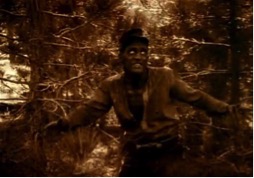
Significantly, white women were considered “repositories of…civilization” (Jordan 148). Any perceived attack upon her was, therefore, perceived as an attack upon civilization. Thus, the black brute symbolized a threat that required suppression through State punishment and that justified the infliction of that punishment. As demonstrated by lynching photography (See Fig. 2), the COC provided the means of advancing such justifications. One strategy for evoking the COC involved contrasting the size and strength of the State’s African-American male victims with the size and strength of the State’s representatives, especially through deployment of verbal descriptions conjuring visual images of the black brute.
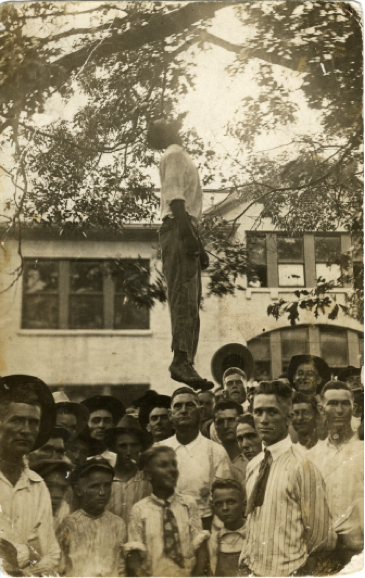
Texts across the nineteenth and twentieth centuries employed this strategy. For example, a pamphlet detailing the lynching of Henry Smith in 1893 contrasts Smith’s “brawny muscular body” (James 3) with the “little” (4) body of his alleged victim, Myrtle Vance, daughter of police officer Henry Vance: “The image of this small, blond girl…was set in contradistinction to the image of Smit[h]” (Wood 386, See Figs. 3 and 4). The New York Times similarly invoked images of the black brute by circulating stories of “giant negroes” during the early decades of the twentieth century. One article, for example, details the “savage ferocity” with which Edward Gurley, a “negro of gigantic build,” reportedly attacked police (“Giant Negro Attacks”). Lastly, defense attorneys during the Rodney King trial in 1993 defended Los Angeles police officers by portraying King as a “monster” with “‘hulk-like strength’” (“Defense”). These examples not only conjure up images of the black brute, but they also do so in ways that contrast the physicality of the State’s representatives with the African-American male victims of its punishment. These contrasts evoke the COC verbally and visually; they employ language and imagery to forge a binary opposition between the State and the men subjected to its violence and to render these men as enemy Others.
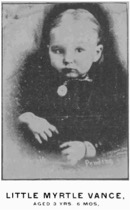
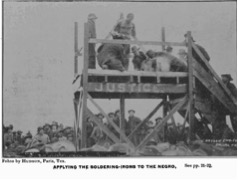
Darren Wilson’s testimony carries this verbal-visual history into the present. For example, the testimony invokes images of the black brute by emphasizing Brown’s size and strength. Wilson first draws attention to Brown’s size by describing Brown as “really big.” Wilson later states that Brown’s head “was higher than the top of [his SUV]”. Wilson, then, stresses Brown’s size when describing their altercation inside of the SUV: “Hulk Hogan, that’s…how big he felt and how small I felt just from grasping his arm.” In addition to emphasizing Brown’s size, Wilson highlights Brown’s strength. While describing their confrontation, Wilson asserts that he “felt like a five-year-old holding onto Hulk Hogan.” Wilson not only adds that Brown was “stronger” than he was, but also that Brown’s punches could have been “fatal.” Lastly, Wilson describes Brown as animal-like and impervious to pain. According to Wilson, Brown “made…a grunting…sound” and then “bulk[ed] up to run through the shots” (“Read Darren Wilson’s”). Like its historical predecessors, Wilson’s testimony uses verbal description to conjure up an image of the black brute that juxtaposes the size and strength of a State representative with that of an African-American male victim of State punishment. This contrast generates a binary opposition between Wilson and Brown that evokes the COC and renders Brown an enemy Other.
Wilson’s activation of the COC’s history not only represents Brown as a black brute, but it also seeks justification for Wilson’s punishment of Brown. Across the diachronic structure of the COC, representations of African-American men as black brutes have sought justification for the punishments inflicted upon them. For example, the pamphlet describing Henry Smith’s lynching asserts that Smith’s punishment was an “appalling necessity” (22) while the size and purported ferociousness of Edward Gurley “forced” police “to kill him” (“Giant Negro Attacks”). Similarly, Rodney King’s perceived strength motivated Sgt. Stacey Koon to order his officers “to beat King repeatedly” (“Defense”). Mobilizing this history, Wilson asserts that Brown was a threat not only to Wilson but also to “anybody else that confronted him” (“Read Darren Wilson’s”). Thus, according to ideographic history, Wilson had to punish Brown.
Normalizing Racialized Violence: The Influence of History
In addition to seeking justification for Wilson’s punishment of Brown, the history Wilson activates illustrates how the verbal-visual dimensions of the COC may be used to normalize State-inflicted symbolic and material violence against African-American men. The history does so by perpetuating these instances of violence in the present. First, it reiterates the COC as a standard framework for representing men like Michael Brown. Second, it justifies repeated acceptance of the State’s enactment of racialized corporeal punishment.
The history Wilson activates seeks to normalize the State’s symbolic violence by reiterating the COC as a standard framework for representing African-American male victims of State punishment. Ideographic history establishes “patterns of usage” (Ewalt 373) that standardize the ways discursive vocabularies communicate ideographs, producing repetitions that remain in “consonance and unity” (McGee 14) with past usages. For example, Wilson’s evocation of the COC repeats the vocabularies used historically to conjure images of the black brute and to warrant State punishment. This repetition reiterates the COC as a standard framework. Moreover, it perpetuates the symbolic violence the State performs through the framework. As Cloud explains, the COC symbolically reduces Others into embodiments of “evil” (291). By reducing African-American men into black brutes, the COC allows the State to negate their complex humanity of these men and to divide them from the human collective to which they belong. Because the COC performs symbolic violence, its reiteration as a standard framework standardizes its violence. Thus, the diachronic structure of the COC makes the ideograph and its violence regular components of America’s symbolic environment, forming this environment into an “imaginary in which all black men threaten white safety” (Lebduska). In doing so, the COC’s diachronic structure seeks to normalize the State’s enactment of symbolic violence against African-American men.
In addition to seeking normalization of the State’s symbolic violence, the verbal-visual history Wilson mobilizes seeks normalization of the State’s material violence. It does so by justifying public acceptance of this violence. Reiterating the COC as a standard framework reiterates its role as an ideology, a “vocabulary of public motives” (Lucaites and Condit 18) that makes political consciousness “empirically ‘present’” (McGee 4). While ideologies fulfill multiple functions, of particular concern is their capacity to “authorize and warrant public actions” (Lucaites and Condit 18). Ideographic history “justif[ies] the form and direction” of these actions (McGee 14), thus allowing the repetition of past actions in the present. One action encouraged by the COC is “consent to repressive [racialized] violence in the domestic arena” (Cloud 300), especially as the COC instructs individuals to “associate images of blacks with violence” (Lebduska). In this case, the ideograph encourages consent to the punishment Wilson/the State inflicted upon Michael Brown. As activated by Wilson’s testimony, the diachronic structure of the COC does not just encourage acceptance; it justifies acceptance. The ideograph’s history, therefore, allows for the repetition of consent. Because consent leaves the State’s material violence against African-American men unchallenged, it allows the violence to be perpetuated. Thus, the diachronic structure of the COC allows the State’s material violence to function as a normalized component of “U.S. political life” (Cloud 288).
A Postscript in Hope
The ideographic history Wilson activates not only provides for the justification and normalization of State-inflicted symbolic and material violence; it also provides for disruption and dissent. Across this history, activists have introduced deviations in the COC, especially as they have altered the ideograph to represent State violence such as lynching and segregation as examples of “white savagery” (Wood 394). We may continue to introduce such deviations. We may, for example, undermine the normalcy of racialized State punishment by describing it with ideographs such as imperialism and terrorism. We may also subvert the “dichotomous needs” (Lebduska) of the COC by rejecting the ideograph’s reductive representations and by offering counter-representations. Disrupting the verbal-visual history of the COC may help us not only to destabilize the racialized violence the ideograph justifies and normalizes but also the human violence the ideograph repeatedly performs.
Endnotes
- Addressing State violence against groups such as African-American women is beyond the scope of this argument. I hope others will expand this argument by examining how the COC has operated in contexts involving the infliction of State violence against such groups. return
Works Cited
- Cloud, Dana L. “‘To Veil the Threat of Terror’: Afghan Women and the Clash of Civilizations in the Imagery of the U.S. War on Terrorism.” Quarterly Journal of Speech 90.3 (2004): 285-306. Web. 13 April 2015.
- “Defense wants Rodney King on Trial.” Ludington Daily News. Shoreline Media Group, 29 March 1993. n. pag. Web. 16 June 2015.
- Ewalt, Joshua. “A Colonialist Celebration of National Heritage: Verbal, Visual, and Landscape Ideographs at Homestead National Monument of America.” Western Journal of Communication 75.4 (2011): 367-85. Web. 9 June 2015.
- Fredrickson, George M. The Black Image in the White Mind: The Debate on Afro-American Character and Destiny, 1817-1914. New York: Harper & Row, 1971. Print.
- “Giant Negro Attacks Police.” The New York Times. 24 Sept. 1900. n. pag. Web. 16 June 2015.
- James, P.L. The Facts in the Case of the Horrible Murder of Little Myrtle Vance and Its Fearful Expiation at Paris, Texas, February 1st, 1893. Paris: P.L. James, 1893. Print.
- Jordan, Winthrop D. White Over Black: American Attitudes Toward the Negro 1550-1812. Chapel Hill: The U of North Carolina P, 1968.
- Lebduska, Lisa. “Racist Visual Rhetoric and Images of Trayvon Martin.” Present Tense 3.2 (2014). n. pag. Web. 29 Aug. 2015.
- Lucaites, John Louis and Celeste Michelle Condit. “Reconstructing Equality: Cultural and Counter-Cultural Rhetorics in the Martyred Black Vision.” Communication Monographs 57 (1990): 5-24. Web. 16 June 2015.
- McGee, Michael Calvin. “The ‘Ideograph’: A Link Between Rhetoric and Ideology.” Quarterly Journal of Speech 66.1 (1980): 1-16. Web. 13 April 2015.
- “Read Darren Wilson’s full grand jury testimony.” The Washington Post. 25 Nov. 2014. n. pag. Web. 16 June 2015.
- Winston, George T. “The Relation of the Whites to the Negroes.” Annals of the American Academy of Political and Social Science. 18 (1901): 105-18. Web. 3 September 2010.
- Wood, Amy Louise. “Lynching Photography and the Visual Reproduction of White Supremacy.” American Nineteenth Century History. 6.3 (2005): 373-99. Web. 30 August 2015.
Cover Image Credit: http://abcnews.go.com/US/ferguson-grand-jury-indict-officer-darren-wilson-death/story?id=27146400


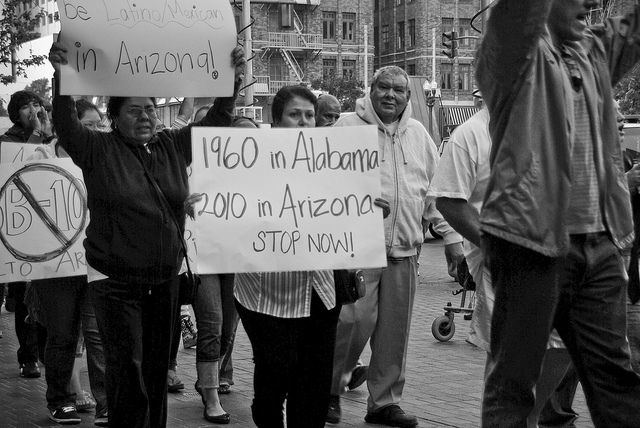
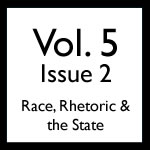
 Scott Gage is an assistant professor at Colorado State University-Pueblo, where he teaches courses in rhetoric and professional writing. He is also involved in El Centro Words and Music, an after-school music and writing program serving students at the El Centro Del Quinto Sol community center.
Scott Gage is an assistant professor at Colorado State University-Pueblo, where he teaches courses in rhetoric and professional writing. He is also involved in El Centro Words and Music, an after-school music and writing program serving students at the El Centro Del Quinto Sol community center.